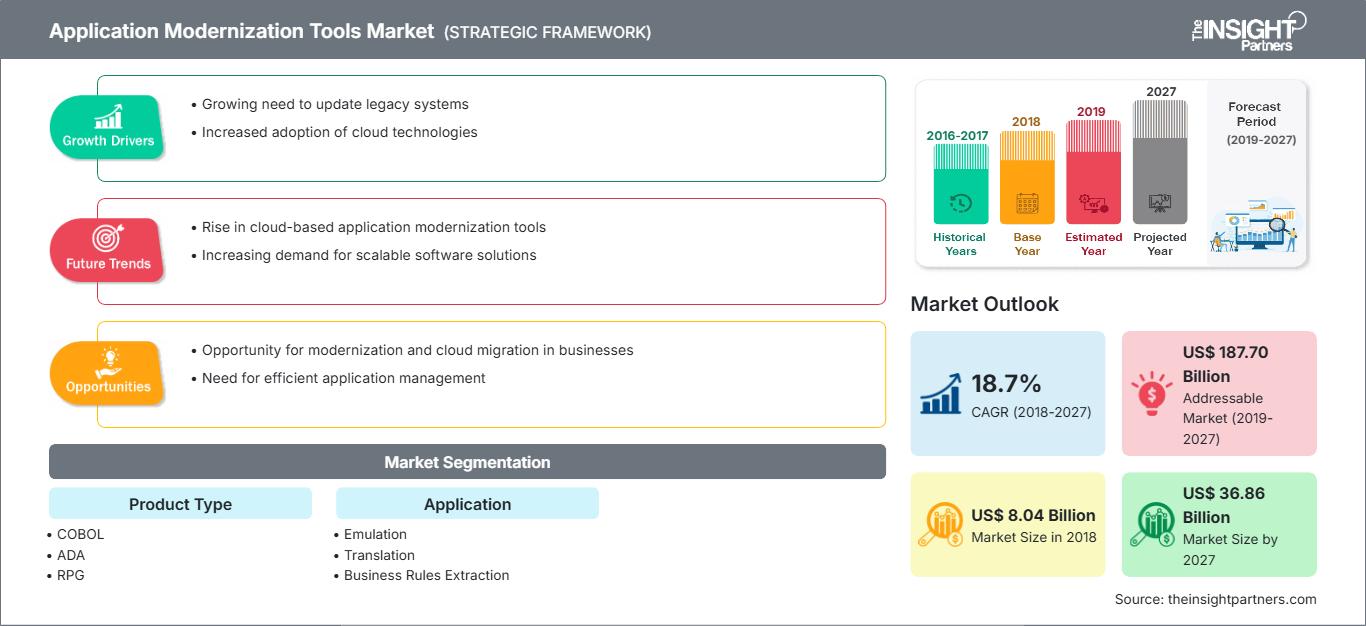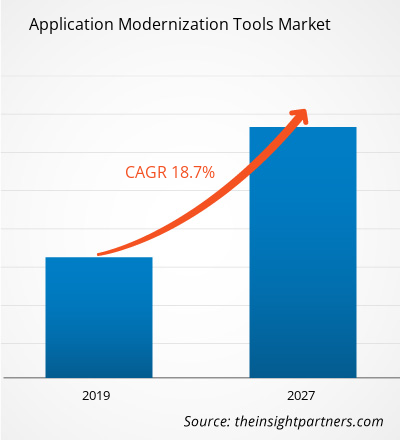2018 年全球应用程序现代化工具市场规模为 80.4 亿美元,预计在 2019 年至 2027 年预测期内将以 18.7% 的复合年增长率增长,到 2027 年将达到 368.6 亿美元。
预计到 2027 年北美将占据应用程序现代化工具市场的最大份额。各国政府正在通过战略性地利用新技术以及数据和高级分析来优化政策和计划并更新其遗留系统,从而最大限度地提高其数字投资。改进和调整流程;吸引新的投资者;在政府运营中引入智能的数据驱动方法;提供更好的信息访问和改进信息管理;提高公民满意度和信任度;转变政府交易服务;满足快速变化的人口结构需求、平衡成本和优化效率,都在政府、公共和私营部门正在进行的 IT 转型中发挥着重要作用。
市场洞察:各行各业日益增长的数字化转型正在推动应用程序现代化工具市场的需求。
端到端业务流程优化、提高运营效率、改善客户体验和降低成本只是推动应用程序现代化工具市场发展的几个因素。企业从传统渠道向数字化和自动化渠道的模式转变带来了多种好处,包括提高效率、降低成本和增加收入机会,从而促进了应用程序现代化工具市场的增长。
自定义此报告以满足您的要求
您将免费获得任何报告的定制,包括本报告的部分内容,或国家级分析、Excel 数据包,以及为初创企业和大学提供超值优惠和折扣
应用程序现代化工具市场: 战略洞察

- 获取本报告的主要市场趋势。这个免费样本将包括数据分析,从市场趋势到估计和预测。
与其他解决方案的高度集成为应用程序现代化工具市场带来了丰厚的机遇。
您将免费获得任何报告的定制,包括本报告的部分内容,或国家级分析、Excel 数据包,以及为初创企业和大学提供超值优惠和折扣
应用程序现代化工具市场: 战略洞察

- 获取本报告的主要市场趋势。这个免费样本将包括数据分析,从市场趋势到估计和预测。
应用程序现代化工具市场的参与者正在将各种解决方案与平板电脑、移动设备和 Web 上的应用程序和前端集成。这是一种经济高效且快速的方法,可在任何应用程序中提供新的业务流程。服务提供商集成了诸如机器人流程自动化 (RPA) 之类的解决方案,这是一个即服务自动化平台。它能够复制技术与人之间的交互,从而以经济高效的方式实现各种操作和支持流程的自动化,并提高可靠性。
产品类型洞察
按产品类型划分的全球应用程序现代化工具市场由 COBOL 细分市场引领。使用传统方法进行应用程序现代化过程颇具挑战性,但随着敏捷技术的采用,它变得更容易、更准确。COBOL 是一种高级编程语言,它可以生成完全基于 Web 的应用程序并在规定时间内重新设计项目,同时执行标准并遵循规范以获得更好的外观和体验,并利用 .NET 和 Java 应用程序进行现代化。市场上各种平台将现有代码转换为高级语言。
应用洞察
2018 年,全球应用程序现代化工具市场中,仿真细分市场占据主导地位。此外,预计到 2027 年,该细分市场将占据应用程序现代化工具市场的最大份额。仿真是一个重新托管/重建现代化方法的过程,该方法通过模拟旧版操作环境来提供在分布式平台上编译的环境。仿真功能减少了旧版系统迁移到分布式平台时发生的变化量。仿真过程提供了将工作负载从大型机迁移出去的最快技术,并且是一种相对低成本、低风险的方式来降低运营成本并维护业务价值。这些因素预计将推动应用程序现代化工具市场对仿真应用程序的需求激增。
应用程序现代化工具市场区域洞察
The Insight Partners 的分析师已详尽阐述了预测期内影响应用程序现代化工具市场的区域趋势和因素。本节还讨论了北美、欧洲、亚太地区、中东和非洲以及南美和中美洲的应用程序现代化工具市场细分和地域分布。
应用程序现代化工具市场报告范围
| 报告属性 | 细节 |
|---|---|
| 市场规模 2018 | US$ 8.04 Billion |
| 市场规模 2027 | US$ 36.86 Billion |
| 全球复合年增长率 (2018 - 2027) | 18.7% |
| 历史数据 | 2016-2017 |
| 预测期 | 2019-2027 |
| 涵盖的领域 |
By 产品类型
|
| 覆盖地区和国家 | 北美
|
| 市场领导者和主要公司简介 |
|
应用程序现代化工具市场参与者密度:了解其对业务动态的影响
应用现代化工具市场正在快速增长,这得益于终端用户需求的不断增长,而这些需求的驱动因素包括消费者偏好的不断变化、技术进步以及对产品优势的认知度不断提高。随着需求的增长,企业正在扩展其产品线,不断创新以满足消费者需求,并利用新兴趋势,从而进一步推动市场增长。

- 获取 应用程序现代化工具市场 主要参与者概述
应用程序现代化工具市场的参与者主要致力于通过实施先进技术来增强产品性能。以下列出了一些近期发展:
- 2019 年:Atos 宣布增强 Atos Managed OpenShift (AMOS) 平台,借助 SyntBots 自动化平台的新集成自动化功能。此次升级是 Atos 与 Red Hat 合作的成果。
- 2018 年:Micro Focus 宣布 Visual Enterprise Suite 4.0 和 COBOL 4.0 正式上市,这标志着其在实现数字化转型愿景方面迈出了关键一步,旨在帮助客户更新核心业务流程和技术。
- 2017 年:Blu Age 宣布与 Advanced 合作,提供其颠覆性解决方案——COBOL 迁移和数据现代化到 Advanced。通过这种合作关系,该公司提供了自动化解决方案,用于将其旧版 COBOL 应用程序转换为 Java 和 .NET。
全球应用程序现代化工具市场细分
按产品类型
- COBOL
- ADA
- RPG
- 汇编器
- PowerBuilder
- 其他
按应用程序
- 仿真
- 翻译
- 业务规则提取
按地理位置
北美洲
- 美国
- 加拿大
- 墨西哥
欧洲
- 法国
- 德国
- 英国
- 俄罗斯
- 意大利
- 欧洲其他地区
亚太地区 (APAC)
- 澳大利亚
- 中国
- 印度
- 日本
- 韩国
- 亚太地区其他地区
中东和非洲 (MEA)
- 沙特阿拉伯
- 南非
- 阿联酋
- MEA 其他地区
南美洲 (SAM)
- 巴西
- 阿根廷
- SAM 其他地区
公司简介
- Advanced Computer Software Group Limited
- Aspire Systems (India) Pvt.有限公司
- Asysco Software BV
- Atos SE
- Blu Age
- Deloitte Touche Tohmatsu Limited
- FreeSoft, Inc.
- 语言可移植性解决方案
- Micro Focus International plc
- Mphasis Limited
- 语义设计,公司
- SoftwareMining Technologies
- The Software Revolution Inc. (TSRI)
- Virtusa Corporation
- 历史分析(2 年)、基准年、预测(7 年)及复合年增长率
- PEST和SWOT分析
- 市场规模、价值/数量 - 全球、区域、国家
- 行业和竞争格局
- Excel 数据集
近期报告
客户评价
购买理由
- 明智的决策
- 了解市场动态
- 竞争分析
- 客户洞察
- 市场预测
- 风险规避
- 战略规划
- 投资论证
- 识别新兴市场
- 优化营销策略
- 提升运营效率
- 顺应监管趋势




















 获取免费样品 - 应用程序现代化工具市场
获取免费样品 - 应用程序现代化工具市场